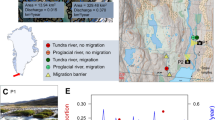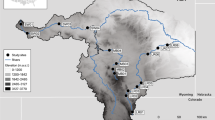Abstract
The numbat (Myrmecobius fasciatus) is a diurnal and exclusively termitivorous marsupial. This study examines interrelationships between diet, metabolic rate and water turnover for wild, free-living numbats. The numbats (488±20.8 g) remained in mass balance during the study. Their basal metabolic rate (BMR) was 3.6 l CO2 day−1, while their field metabolic rate (FMR) was 10.8±1.22 l CO2 day−1 (269±30.5 kJ day−1). The ratio FMR/BMR was 3±0.3 for numbats. We suggest that the most accurate way to predict the FMR of marsupials is from the regression log FMR=0.852 log BMR+0.767; (r 2=0.97). The FMR of the numbat was lower than, but not significantly different from, that of a generalised marsupial, both before (76%) and after (62–69%) correction for the significant effect of phylogeny on FMR. However the numbat's FMR is more comparable with that of other arid-habitat Australia marsupials (98–135%), for which the regression relating mass and FMR is significantly lower than for nonarid-habitat marsupials, independent of phylogeny. The field water turnover rate (FWTR) of free-living numbats (84.1 ml H2O day−1) was highly correlated with FMR, and was typical (89–98%) of that for an arid-habitat marsupial after phylogenetic correction. The higher than expected water economy index for the numbat (FWTR/FMR=0.3±0.03) suggests that either the numbats were drinking during the study, the water content of their diet was high, or the digestibility of their termite diet was low. Habitat and phylogenetic influences on BMR and FMR appear to have pre-adapted the numbat to a low-energy termitivorous niche.



Similar content being viewed by others
Abbreviations
- BMR:
-
basal metabolic rate
- FMR :
-
field metabolic rate
- EWL:
-
evaporative water loss
- FWTR:
-
field water turnover rate
- MR:
-
metabolic rate
- PVR:
-
phylogenetic vector regression
- RER:
-
respiratory exchange ratio
- Ta :
-
ambient temperature
- Tb :
-
body temperature
- TBW:
-
total body water
- V̇CO2 :
-
rate of carbon dioxide production
- V̇O2 :
-
rate of oxygen consumption
- WEI:
-
water economy index
- WER :
-
water efflux rate
- WIR :
-
water influx rate
References
Anderson MD, Williams JB, Richardson PRK (1997) Laboratory metabolism and evaporative water loss of the aardwolf, Proteles cristatus. Physiol Zool 70:464–469
Bradshaw SD, Morris KD, Dickman CR, Withers PC, Murphy D (1994) Field metabolism and turnover in the Golden Bandicoot (Isoodon auratus) and other small mammals from Barrow Island, Western Australia. Aust J Zool 42:29–41
Bradshaw SD, Cohen D, Katsaros A, Tom J, Owen FJ (1987) Determination of 18O by prompt nuclear reaction analysis: application for measurement of microsamples. J Appl Physiol 63:1296–1302
Calaby JH (1960) Observations on the banded ant-eater Myrmecobius f. fasciatus Waterhouse (Marsupialia), with particular reference to its food habits. Proc Zool Soc Lond 135:183–207
Campeau-Peloquin A, Kirsch JAW, Eldridege MDB, Lapointe FJ (2001) Phylogeny of the rock-wallabies, Petrogale (Marsupialia: Macropodidae) based on DNA/DNA hybridisation. Aust J Zool 49:463–486
Cooper CE, Withers PC (2002) Metabolic physiology of the numbat (Myrmecobius fasciatus). J Comp Physiol B 172:669–675
Dawson TJ, Blaney CE, Munn AJ, Krockenberger A, Maloney SK (2000) Thermoregulation by kangaroos from mesic and arid habitats: Influence of temperatures on routes of heat loss in eastern grey kangaroos (Macropus giganteus) and red kangaroos (Macropus rufus). Physiol Biochem Zool 73:374–381
Degen AA, Kam M (1995) Scaling of field metabolic rate to basal metabolic rate ratio in homeotherms. Ecoscience 2:48–54
Diniz-Filho JAF, Sant'Ana de CER, Bini LM (1998) An eigenvector method for estimating phylogenetic inertia. Evolution 52:1247–1262
Edwards D, Westerman M (1995) The molecular relationships of possum and glider families as revealed by DNA–DNA hybridisations. Aust J Zool 43:231–240
Felsenstein J (1985) Phylogenies and the comparative method. Am Nat 125:1–15
Friend AJ (1982) The numbat—an endangered specialist. Aust Nat Hist 20:339–342
Friend JA (1986) Diel and seasonal patterns of activity in the numbat (Myrmecobius fasciatus) (abstract). Aust Mamm Soc Bull 9:47
Friend JA (1993) Myrmecobiidae. In: Glasby GJ, Ross GJB, Beesley PL (Eds) Fauna of Australia. Australian Government, Canberra, pp 583–590
Garland T, Harvey PH, Ives AR (1992) Procedures for the analysis of comparative data using phylogenetically independent contrasts. Syst Biol 41:18–32
Gibson LA, Hume ID (2000) Seasonal field energetics and water influx rates of the greater bilby (Macrotis lagotis). Aust J Zool 48:225–239
Green B, Griffiths M, Newgrain K (1992) Seasonal patterns in water, sodium and energy turnover in free-living echidnas, Tachyglossus aculeatus (Mammalia: Monotremata). J Zool (Lond) 227:351–365
Griffiths M (1968) Echidnas. Pergamon, London
Hume ID (2003) Nutrition of carnivorous marsupials. In: Jones M, Dickman C, Archer M (eds) Predators with pouches: the biology of carnivorous marsupials. CSIRO, Collingwood, pp 221–228
Kirsch JAW, Lapointe FJ, Springer MS (1997) DNA-hybridisation studies of marsupials and their implications for metatherian classification. Aust J Zool 45:211–280
Koteja P (1991) On the relation between basal and field metabolic rates in birds and mammals. Funct Ecol 5:56–64
Krajewski C, Wroe S, Westerman M (2000) Molecular evidence for the pattern and timing of cladogenesis in dasyurid marsupials. Zool J Linn Soc 130:375–404
McNab BK (1984) Physiological convergence amongst ant-eating and termite-eating mammals. J Zool (Lond) 203:485–510
McNab BK (1986) The influence of food habits on the energetics of placental mammals. Ecol Monogr 56:1-19
McNab BK (2000) Energy constraints on carnivore diet. Nature 407:584
Nagy KA (1975) Water and energy budgets of free-living animals: measurement using isotopically labeled water. In: Hadley NF (ed) Environmental physiology of desert organisms. Dowden, Hutchinson and Ross, Stroudsburg, Pa, pp 227–245
Nagy KA (1983) The doubly labeled water (3HH18O) method: a guide to its use. University of California in Los Angeles Publication no. 12:1–45
Nagy KA (1987) Field metabolic rate and food requirement scaling in mammals and birds. Ecol Monogr 57:111–128
Nagy KA (1994) Field bioenergetics of mammals: what determines field metabolic rates? Aust J Zool 42:43–53
Nagy KA (1999) Doubly labeled water studies of vertebrate physiological ecology. In: Rundel PW, Ehleringer JR, Nagy KA (eds) Stable isotopes in ecological research. Springer, Berlin Heidelberg New York, pp 270–287
Nagy KA, Bradshaw SD (2000) Scaling of energy and water fluxes in free-living arid-zone Australian marsupials. J Mamm 81:962–970
Nagy KA, Peterson CC (1988) Scaling of water flux rate in animals. Univ Calif Publ Zool 120:1–172
Nagy KA, Huey RB, Bennett AF (1984) Field energetics and foraging mode of Kalahari lacertid lizards. Ecology 65:588–596
Nagy KA, Bradley AJ, Morris KD (1990) Field metabolic rates, water fluxes and feeding rates of quokkas (Setonix brachyurus) and tammars (Macropus eugenii) in Western Australia. Aust J Zool 37:553–560
Nagy KA, Girard IA, Brown TK (1999) Energetics of free-ranging mammals, reptiles and birds. Annu Rev Nutr 19:247–277
Redford KH, Dorea JG (1984) The nutritional value of invertebrates with emphasis on ants and termites as food for mammals. J Zool (Lond) 203:385–395
Rohlf FJ (2001) Comparative methods for the analysis of continuous variables: geometric interpretations. Evolution 55:2143–2160
Schleucher E, Withers PC (2002) Metabolic and thermal physiology of pigeons and doves. Physiol Biochem Zool 75:439–450
Speakman JR (1997) Doubly labelled water: theory and practice. Chapman and Hall, London
Speakman JR (2000) The cost of living: field metabolic rates of small mammals. In: Fitter AH, Raffaelli DG (Eds) Advances in ecological research. Academic Press, New York, pp 177–297
Williams JB, Anderson MD, Richardson PRK (1997) Seasonal differences in field metabolism, water requirements and foraging behaviour of free-living aardwolves. Ecology 78:2588–2602
Withers PC (2001) Design, calibration and calculation for flow-through respirometry systems. Aust J Zool 49:445–461
Withers PC, Bradshaw SD (1995) Water and energy balance of the thorny devil Moloch horridus: is the devil a sloth? Amphibia-Reptilia 16:47–54
Withers PC, Thompson GG, Seymour RS (2000) Metabolic physiology of the north-western marsupial mole, Notoryctes caurinus (Marsupialia: Notorycidae). Aust J Zool 48:241–258
Zar JH (1999) Biostatistical analysis. Prentice-Hall, Englewood Cliffs, N.J.
Acknowledgements
We are extremely grateful to Dr Tony Friend and Neil Thomas, Department of Conservation and Land Management, for permission to work with the numbats, for locating and capturing the numbats, and for continual support throughout the study. We thank Dr Kristen Warren and Dr Ralph Swan, Murdoch University, for taking the blood samples, Felicity Bradshaw for all her assistance in the laboratory, and Alex Larcombe for his assistance in the field. We thank the reviewers of this manuscript for their particularly helpful comments. This study was approved by the University of Western Australia Animal Ethics Committee, and was supported by an APRA to C. Cooper and by the Australian Governments Cooperative Research Centres Program through funds from the CRC for Conservation and Management of Marsupials.
Author information
Authors and Affiliations
Corresponding author
Additional information
Communicated by I.D. Hume
Rights and permissions
About this article
Cite this article
Cooper, C.E., Withers, P.C. & Bradshaw, S.D. Field metabolic rate and water turnover of the numbat (Myrmecobius fasciatus). J Comp Physiol B 173, 687–693 (2003). https://doi.org/10.1007/s00360-003-0380-6
Accepted:
Published:
Issue Date:
DOI: https://doi.org/10.1007/s00360-003-0380-6




